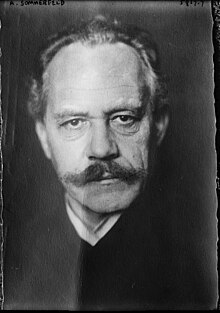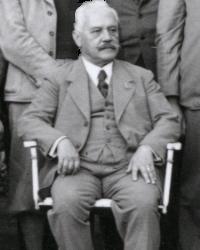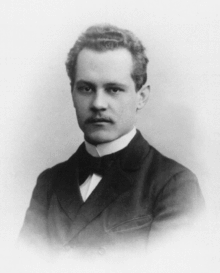Arnold Sommerfeld
Arnold Johannes Wilhelm Sommerfeld, ForMemRS [1] ( Njemački: [ˈzɔmɐˌfɛlt] ; 5. decembar 1868. – 26. april 1951.) bio je njemački teorijski fizičar koji je bio pionir razvoja atomske i kvantne fizike, a također je obrazovao i podučavao mnoge studente za novu eru teorijske fizike. Bio je supervizor doktorskih studija za mnoge dobitnike Nobelove nagrade za fiziku i hemiju (samo je JJ Thomsonov mentorski zapis uporediv s njegovim).
Uveo je drugi kvantni broj (azimutalni kvantni broj) i treći kvantni broj (magnetni kvantni broj). Također je uveo konstantu fine strukture i pionirsku teoriju rendgenskih valova.
Sommerfeld je studirao matematiku i fizičke nauke na Univerzitetu Albertina u svom rodnom gradu, Königsbergu, Istočna Pruska. Njegov savjetnik za disertaciju bio je matematičar Ferdinand von Lindemann,[2] a također je imao koristi od nastave kod matematičara Adolfa Hurwitza i Davida Hilberta i fizičara Emila Wiecherta.[3] Njegovo učešće u studentskom bratstvu Deutsche Burschenschaft rezultiralo je ožiljkom od duela na njegovom licu.[4] Doktorirao je. 24. oktobra 1891. godine (22 godine). [5]
Nakon što je doktorirao, Sommerfeld je ostao u Königsbergu da radi na svojoj diplomi nastavnika. Državni ispit je položio 1892. godine, a zatim je počeo godinu dana služenja vojnog roka, što je odslužio u rezervnom puku u Königsbergu. Obavezno služenje vojnog roka odslužio je septembra 1893. godine, a narednih osam godina nastavio je dobrovoljno služenje vojnog roka od osam sedmica. Sa podignutim brkovima, svojom tjelesnom građom, pruskim držanjem i ožiljkom od mačevanja na licu, odavao je utisak pukovnika husara.[4]

Od 1906. Sommerfeld se uspostavio kao redovni profesor fizike i direktor novog Instituta za teorijsku fiziku na Univerzitetu u Minhenu. Odabrao ga je za ove pozicije Wilhelm Röntgen, direktor Instituta za fiziku u Minhenu,[6] za kojeg je Sommerfeld smatrao da je pozvan u "privilegiranu sferu djelovanja".[7]
Četvorica Sommerfeldovih doktorskih studenata, [8] Werner Heisenberg, Wolfgang Pauli, Peter Debye i Hans Bethe osvojili su Nobelove nagrade, dok su drugi, među kojima su najznačajniji, Walter Heitler, Rudolf Peierls, Karl Bechert, Hermann Brück, Paul Peter Ewald, Eugene Feenberg, [9] Herbert Fröhlich, Erwin Fues, Ernst Guillemin, Helmut Hönl , Ludwig Hopf, Adolf Kratzer, Otto Laporte, Wilhelm Lenz, Karl Meissner, [10] Ernst Guillemin, Ernstrich Welger, E. Gregor Wentzel, Alfred Landé i Léon Brillouin postali su poznati sami po sebi. Trojica Sommerfeldovih postdoktorskih studenata, Linus Pauling, Isidor I. Rabi [11] i Max von Laue, [12] dobili su Nobelove nagrade, a deset drugih, William Allis, [13] Edward Condon, Carl Eckart, [14] Edwin C. Kemble, [15] William V. Houston, [16] Karl Herzfeld, Walther Kossel, Philip M. Morse, [17] [18] Howard Robertson, [19] i Wojciech Rubinowicz [20] ] [21] su postali poznati sami po sebi. Walter Rogowski, student dodiplomskih studija u Sommerfeldu na RWTH Aachenu, također je postao poznat sam po sebi. Max Born je vjerovao da Sommerfeldove sposobnosti uključuju "otkrivanje i razvoj talenata". [22] Albert Einstein je rekao Somerfeldu: "Ono čemu se posebno divim kod vas je to što ste, takoreći, izvukli iz tla tako veliki broj mladih talenata." [22] Sommerfeldov stil kao profesora i direktora instituta nije pravio distancu između njega i njegovih kolega i studenata. Pozivao ih je na saradnju, a njihove ideje su često uticale na njegove stavove o fizici. Zabavljao ih je u svom domu i sastajao se s njima u kafićima prije i poslije seminara i kolokvijuma. Sommerfeld je posjedovao kolibu za alpsko skijanje u koju su studenti često bili pozivani na diskusije o fizici koja je zahtjevna kao i sport. [23]

Reference
[uredi | uredi izvor]Ovaj odlomak nije preveden ili je djelimično preveden. |
- ^ Born, Max (1952). "Arnold Johannes Wilhelm Sommerfeld. 1868–1951". Obituary Notices of Fellows of the Royal Society. 8 (21): 274–296. doi:10.1098/rsbm.1952.0018. JSTOR 768813.
- ^ The Mathematics Genealogy Project (Arnold Sommerfeld Error in Webarchive template: Empty url.) cites Ferdinand von Lindemann as Sommerfeld's Ph.D. dissertation advisor. Cassidy (Cassidy, 1992, pp. 100 – 101) cites Paul Volkmann as Sommerfeld's advisor and cites a reference. Other authors provide information which can be used to decide between the two, in view of Sommerfeld's abilities. The English translation of Sommerfeld's Habilitationsschrift (Arnold Sommerfeld, translated by Raymond J. Nagem, Mario Zampolli, and Guido Sandri Mathematical Theory of Diffraction, Birkhäuser Boston, 2003, pp. 1–2) reveals that Sommerfeld's Ph.D. thesis cited 14 of his teachers at the University of Königsberg and thanked all of them, but particularly named Lindemann in the line of gratitude. Jungnickel (Jungnickel, 1990b, pp. 144–148 and 157–160) is revealing on a number of issues relating to Volkmann. He did little research himself, did not attract physicists, had few publications to his name, and as a physics teacher was a "popularizer". While Sommerfeld attended classes in Volkmann's Theoretical Physics Institute at Königsberg, he looked to Volkmann's assistant Emil Wiechert, rather than Volkmann himself. Sommerfeld was closely associated with Emil Wiechert, who gave him many impressions. Wilfried Schroeder has published the earlier letters between Sommerfeld and Wiechert (Arch. hist. ex. sci., 1984). At the end of the 19th and the early 20th century, there were only four ordinarius professorships for theoretical physics: Königsberg (Volkmann), Göttingen (Woldemar Voigt), Berlin (Max Planck), and Munich, which had been vacant since Ludwig Boltzmann left in 1894, and would not be filled until Sommerfeld was appointed there in 1906. In comments made on the status of theoretical physics in 1899, Voigt only mentioned Planck, Wilhelm Wien, Paul Drude, and Sommerfeld. In a letter to Sommerfeld in 1898, Wien's assessment was similar to Voigt's; Wien only mentioned the chairs at Berlin and Göttingen. Keeping in mind that Munich was unfilled, not mentioning Volkmann's chair at Königsberg to Sommerfeld was a glaring omission, with implications.
- ^ Mehra, Volume 1, Part 1, 1982, p. 106.
- ^ a b Sommerfeld Biography Error in Webarchive template: Empty url. – MacTutor History of Mathematics
- ^ Arnold Sommerfeld Error in Webarchive template: Empty url. – Mathematics Genealogy Project. Sommerfeld's Ph.D. thesis title: Die willkürlichen Functionen in der mathematischen Physik.
- ^ Jungnickel, 1990b, pp. 274, 277–278, and 281–285.
- ^ Arnold Sommerfeld, translated from the fourth German edition by Martin O. Stern Mechanics – Lectures on Theoretical Physics Volume I (Academic Press, 1964), pp. v – x. (Foreword by Paul Peter Ewald and Preface by Sommerfeld.)
- ^ Arnold Sommerfeld’s Students Error in Webarchive template: Empty url. – The Mathematics Genealogy Project and Arnold Sommerfeld – Kommunikation und Schulenbildung Error in Webarchive template: Empty url..
- ^ Eugene Feenberg did doctoral studies with Sommerfeld and completed his Ph.D. in 1933 under Edwin C. Kemble at Harvard University.
- ^ After one year at Munich studying with Sommerfeld, Karl Meissner returned to Tübingen to be able to study spectroscopy with Friedrich Paschen, under whom he received his doctorate in 1915. See: K. W. Meissner reviews: Arnold Sommerfeld, translated from the first German edition by Otto Laporte and Peter A. Moldauer Optics – Lectures on Theoretical Physics Volume IV. American Journal of Physics 23 (7) 477–478 (1955). The author states that he attended Sommerfeld's lectures, and specifically on optics, in 1912.
- ^ After earning his Ph.D. in 1927, Rabi, aided by fellowships, went to Europe for two years to do postgraduate work under Sommerfeld, Niels Bohr, Wolfgang Pauli, Otto Stern, and Werner Heisenberg. See: Isidor Isaac Rabi – Biographical Error in Webarchive template: Empty url.. See also: Arnold Sommerfeld Some Reminiscences of My Teaching Career, American Journal of Physics 17 315–316 (1949). In the article, Sommerfeld specifically mentions as his (postdoctoral) students the Americans Linus Pauling, Edward U. Condon, and I. I. Rabi. See also: I. I. Rabi, translated and edited by R. Fraser Code Stories from the early days of quantum mechanics, Physics Today (8) 36–41 (2006). In the article, Rabi comments on his experience as a postdoctoral student of Sommerfeld.
- ^ Walker, 1995, p. 73. Von Laue completed his Habilitation in 1906.
- ^ During the 1930–1931 academic year, Allis spent the first half with Sommerfeld and the last half at the University of Cambridge. He was traveling with Philip M. Morse. See: Philip M. Morse In at the Beginnings: A Physicists Life (MIT Press, second printing 1978) p. 100.
- ^ In 1927 and 1928, Eckart had a Guggenheim Fellowship, which he used to go to Germany to do postgraduate study with Arnold Sommerfeld at the Ludwig Maximilians University of Munich and Werner Heisenberg at the University of Leipzig. Eckart Biography – The National Academies Press and Author Catalog: Eckart Error in Webarchive template: Empty url. – American Philosophical Society. See also Arnold Sommerfeld, Some Reminiscences of My Teaching Career, American Journal of Physics 17 (5) 315–316 (1949).
- ^ Edwin C. Kemble went to Munich and Göttingen in 1927–1928 to study and do research with Sommerfeld and Max Born, respectively.
- ^ In 1927 and 1928, Houston had a Guggenheim Fellowship, which he used to go to Germany to do postgraduate study with Sommerfeld at the Ludwig Maximilians University of Munich and Werner Heisenberg at the University of Leipzig. Houston Biography Error in Webarchive template: Empty url. – The National Academies Press. See also Arnold Sommerfeld Some Reminiscences of My Teaching Career, American Journal of Physics 17 (5) 315–316 (1949).
- ^ Paul Kirkpatrick Address of Recommendation by Professor Paul Kirkpatrick, Chairman of the Committee on Awards, American Journal of Physics 17 (5) 312–314 (1949). In this article, the following students of Arnold Sommerfeld are mentioned: William V. Houston, Karl Bechert, Otto Scherzer, Otto Laporte, Linus Pauling, Carl Eckart, Gregor Wentzel, Peter Debye, and Philip M. Morse.
- ^ Philip M. Morse In at the Beginnings: A Physicists Life (MIT Press, second printing 1978) p. 100.
- ^ I. I. Rabi, translated and edited by R. Fraser Code Stories from the early days of quantum mechanics, Physics Today (8) 36–41 (2006) p. 38.
- ^ Rubinowicz was at Munich from 1916 to 1918.
- ^ Rubinowicz was at Munich from 1916 to 1918.
- ^ a b Jungnickel, 1990b, p. 284, quoting from references given in Footnote 100 on the page.
- ^ Jungnickel, 1990b, p. 283.
